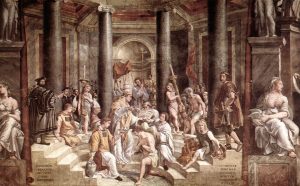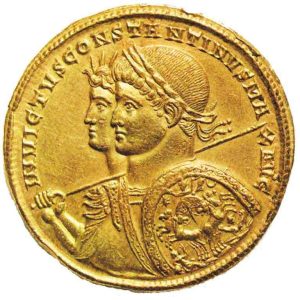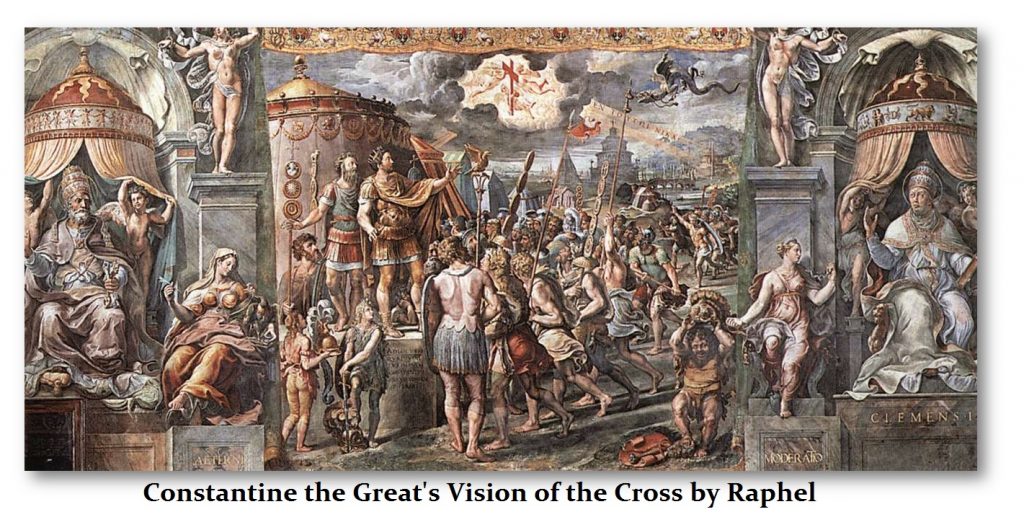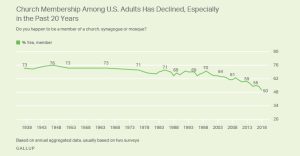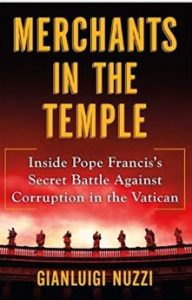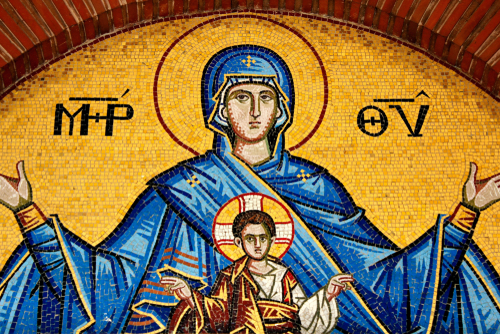In truth, everything has its cycle. There is no escaping this reality upon which the entire universe was created. There has been a steady decline in church membership which has been consistent with perhaps the politically correct movement with the broader societal trends that also manifest in the declining church attendance. There appears to be a rising trend of an increasing proportion of Americans with no religious preference which is strikingly similar to the decline in religion which took place within the Roman Empire.
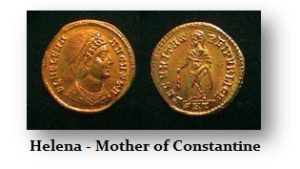 Indeed, Constantine’s (309-337AD) decision to decriminalize Christianity within the Roman Empire was a turning point for religious change cyclically. It was the year 313AD, when Constantine and Licinius issued the Edict of Milan decriminalizing Christian worship. Constantine thus became a great patron of Christianity but keep in mind his mother, Helena, was a devout Christian. She searched all the holy places and constructed churches over them from where Christ was born to where he was crucified.
Indeed, Constantine’s (309-337AD) decision to decriminalize Christianity within the Roman Empire was a turning point for religious change cyclically. It was the year 313AD, when Constantine and Licinius issued the Edict of Milan decriminalizing Christian worship. Constantine thus became a great patron of Christianity but keep in mind his mother, Helena, was a devout Christian. She searched all the holy places and constructed churches over them from where Christ was born to where he was crucified.
Note that the medallion pictured here showed Constantine with Sol, the sun god. The cult of Sol was becoming the supreme god even among the pagans – Sol Invictus (invincible sun because it roise every day no matter what). Constantine had set a precedent for the position of the Christian emperor within the Church and raised the notions of orthodoxy, Christendom, ecumenical councils, and the state church of the Roman Empire was officially declared by edict in 380AD. However, Constantine was not really such a devout believer. He adopted Christianity because the movement was rising substantially when people prayed to the pagan golds and nothing happened. The Christians exploited that and argued that the reason their pagan protectors failed was because they did not exist. The pagans, on the other hand, persecuted Christians because the barbarian invasions and the fall of the Roman Empire was taking place because the gods were angry at the Christians.
Constantine sought to be the sole emperor. He really wages civil war. He took a risk to move against Maxentius’ forces which greatly outnumbered his own. Constantine descended through the Genevre Pass and entered Italy. Several battles were fought as Constantine neared Rome itself. The final battle came on October 28th, 312 AD at Milvian Bridge. It was this battle where Constantine I claimed to have had a vision of Christ and marched against Maxentius under the Christian symbol of the cross. Despite the biased historical accounts, the Battle of Milvian Bridge was less of a battle between Christianity and paganism as it was a battle for power and control. While Maxentius may have been a pagan, he did not persecute the Christians and in fact built the first Christian church in Rome. Many of his own troops were Christians. No doubt, Constantine realized that placing the cross on the shield of his army would disrupt his opposing force. Many were Christian and were reluctant to kill a fellow Christian. It was a brilliant move.
Historians have written much of the Battle of Milvian Bridge. It has been characterized as the battle between Christianity and Paganism. As Maxentius’ troops began to retreat across a temporary bridge constructed upon boats, Maxentius fell into the water when the bridge collapsed along with thousands of his troops. His armor proved too heavy and thus he drowned in the waters of the Tiber. That ended the battle.
It is not certain when Jesus Christ was actually born. The census that is the story of having to travel to Bethlehem was actually the Census of Quirinius which took place in 6AD after Herod I the Great had died and the Romans were dividing Judaea into thirds among Herod’s sons. There is no actual evidence of Herod issuing an order to kill the firstborn males when in fact he clearly died about 10 years before. Such an order would have to have been issued by one of his sons, yet there is no surviving evidence to support that as fact.
Nevertheless, our model does place a turning point about late 3AD when most scholars agree that Jesus was born based primarily upon the Census of Quirinius. We then have in 312AD the victory of Milvian Bridge by Constantine the Great who then decrees that Christianity will be the state religion primarily so he got to plunder all the wealth of pagan temples. It is rather stunning how we come to major religious events every 309.6 years. This appears to be a change in beliefs that do not necessarily suggest complete changes in religions. Often these are shifts that become more fundamentalist in their beliefs or a turn toward liberalism.

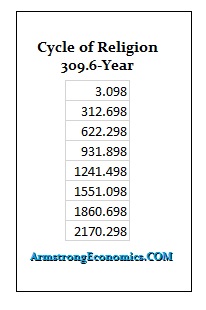 There are two primary cycles. First we can look at the cycle of change in religion which seems to follow the 309.6 year cycle which is, of course, the 8.6-year frequency. The second is to look at the derivative of the 8.6-year which produces a target for a major collapse in religion, which is underway at this time, by 2033.
There are two primary cycles. First we can look at the cycle of change in religion which seems to follow the 309.6 year cycle which is, of course, the 8.6-year frequency. The second is to look at the derivative of the 8.6-year which produces a target for a major collapse in religion, which is underway at this time, by 2033.
From the Battle of the Milvian Bridge which took place between the Roman Emperors Constantine I and Maxentius on the 28th day of October 312AD (312.824), it was 309.6 years until the rise of Islam. At the age of 40 in 610AD, Muhammad is said to have received his first verbal revelation in the cave called Hira.
This was the beginning of the writing of the Quran that continued up to the end of his life. There was also the persecution of the newly converted Muslims like there had been among the Christians. Muhammad and his followers migrated to Medina in 622AD, an event known as the Hegira and the birth of the Islam calendar (622.298).
The next cycle produced the target where we see the beginning of pilgrimages to the Middle East during the 10th century. The belief that the world would end come the year 1,000 was very prominent, so much so that the English King Aethelred II (978-1016AD) replaced his image on the coinage with the symbol of Christianity – the lamb. We seem to fear whole even numbers like the 2000 Y2K bug which was going to destroy all computers.
The next target was 1241 which was the year of the Great Mongol Invasion. Poland fell to the Mongols that year who are eventually beaten back. We also see in this cycle was a new trend of Antipopes when France seized the Catholic Church and installed French popes as puppets of the French king that became known as the Avignon Papacy. This was the period from 1309 to 1376 during which seven successive popes resided in Avignon. The Seventh Crusade was a crusade led by Louis IX of France from 1248 to 1254. This was the cycle that we see Constantinople fall to the Turks in 1453.
 The next cycle turning point began in 1551 when the Council of Trent reconvened to deal with the Protestant Reformation. This cycle also marks the attempt of Islam to conquer Europe and impose Islam as the state religion. The invading army was the new Ottoman Empire, which was defeated at the Battle of Vienna which took place on the 12th of September 1683 after the imperial city had been besieged by the Ottoman Empire for two months. The peak of that cycle arrives 212 years from the beginning. That was 1763 and the start of George II restrictions placed upon Americans which led to the American Revolution, which was also about the freedom of religion.
The next cycle turning point began in 1551 when the Council of Trent reconvened to deal with the Protestant Reformation. This cycle also marks the attempt of Islam to conquer Europe and impose Islam as the state religion. The invading army was the new Ottoman Empire, which was defeated at the Battle of Vienna which took place on the 12th of September 1683 after the imperial city had been besieged by the Ottoman Empire for two months. The peak of that cycle arrives 212 years from the beginning. That was 1763 and the start of George II restrictions placed upon Americans which led to the American Revolution, which was also about the freedom of religion.
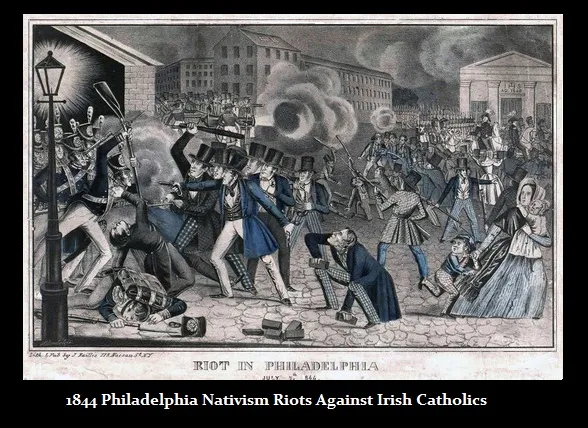 This brings us to 1860 and this is the beginning of the American Civil War, which was rooted in a religious question concerning slavery. This current cycle will reach its peak in 2072 and the next will begin in 2170. We are clearly moving toward a clash of philosophies both within Christianity as well as among different religious foundations. As we move into that major turning point, we will see rising discontent and religious confrontation engulf the world. In the USA, we have the liberal v conservative confrontation which is also incorporating the religious right and anti-abortion movements v women’s liberation factions. They see this as plain and simple – thous shalt not kill. Yet this is inconsistent with the idea of war itself. Perhaps it is ok to kill someone if the government tells you to do it?
This brings us to 1860 and this is the beginning of the American Civil War, which was rooted in a religious question concerning slavery. This current cycle will reach its peak in 2072 and the next will begin in 2170. We are clearly moving toward a clash of philosophies both within Christianity as well as among different religious foundations. As we move into that major turning point, we will see rising discontent and religious confrontation engulf the world. In the USA, we have the liberal v conservative confrontation which is also incorporating the religious right and anti-abortion movements v women’s liberation factions. They see this as plain and simple – thous shalt not kill. Yet this is inconsistent with the idea of war itself. Perhaps it is ok to kill someone if the government tells you to do it?
This is part of the religious cycle as well. We will also see the conflict between Christianity and Islam build in Europe. This will be no different from the anti-immigration movement that surged into gun battles on the streets of Philadelphia during the economic depression that followed the Sovereign Debt Defaults by states during the 1840s. As the economic decline picks up speed from 2018 into 2020, the tensions against immigration will only rise. This is also behind the separatist movements in Europe.
While we are currently in the Seventh Wave 309.6-year cycle following the birth of Christ, from a pure cyclical perspective, the next turning point in 2072 may be a significant religious change. What comes, can only be subject to speculation. We have completed six waves of 309.6 years. The Seventh is where major change and conflict will be unleashed. However, if we just look at Christianity, from the Edit of 313AD decriminalizing this religion, then 2 x 8.6 = 17.2. Therefore, 1720 years from 313AD brings us to 2033 which aligns with the Sixth Wave of the ECM – 2032.
Further confirmation that we are in a major Private Wave is that the belief systems also shifts not merely away from government (Public v Private) but also from formalized religion and even sports. The evidence is very clear that church memberships have been declining. The various church membership data reflected the steady decline from the 76% level to the 50% level. There has been rising discontent even within the Catholic Church over the left-wing statement of Pope Francis. He has been alienating many Catholics. He has adopted the climate change agenda and supported the United Nations in this anti-industrialization movement. He has also adopted the Piketty argument against capitalism supporting the Marxist view of economic inequality. Many feel he has abandoned the faith since one of the Ten Commandments is thou shall not covert what other people have. This has led many to question if he is not just expressing his personal beliefs disguised as religion.
What is clear is that under Pope Francis, the finances of the Church has been declining significantly. Some argue it is due to his political statements that are not grounded in religion. There is a rather famous Italian investigative journalist, Gianluigi Nuzzi, whose new book, Universal Judgment, is the latest in a string of reveling dispatches on financial crises which he has helped to uncover within the church. In his latest book, he warns that the Vatican will run out of funds by 2023. Certainly, the attendance is declining sharply. His previous book, Merchants in the Temple, focused on the internal corruption in the Vatican bank.

